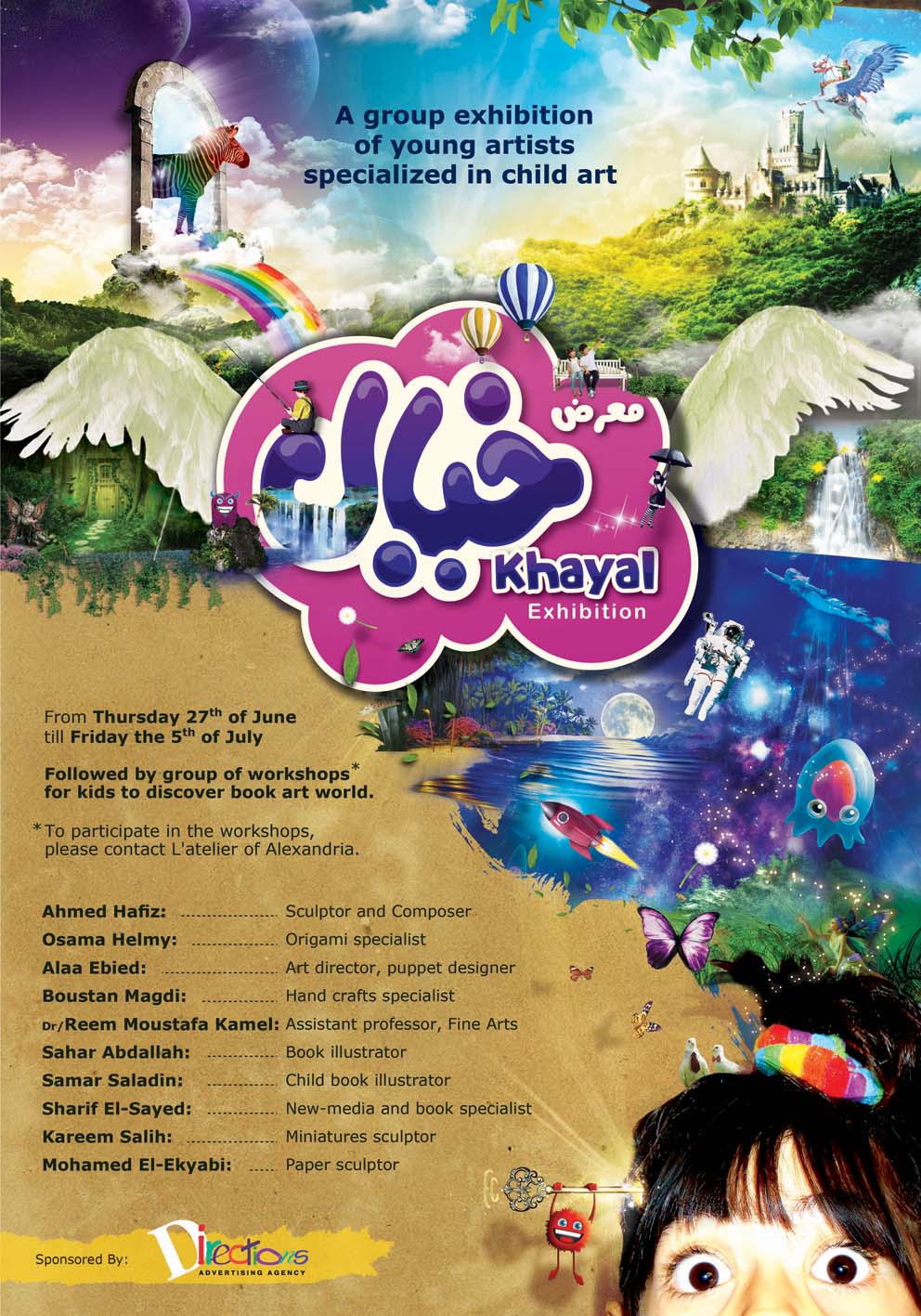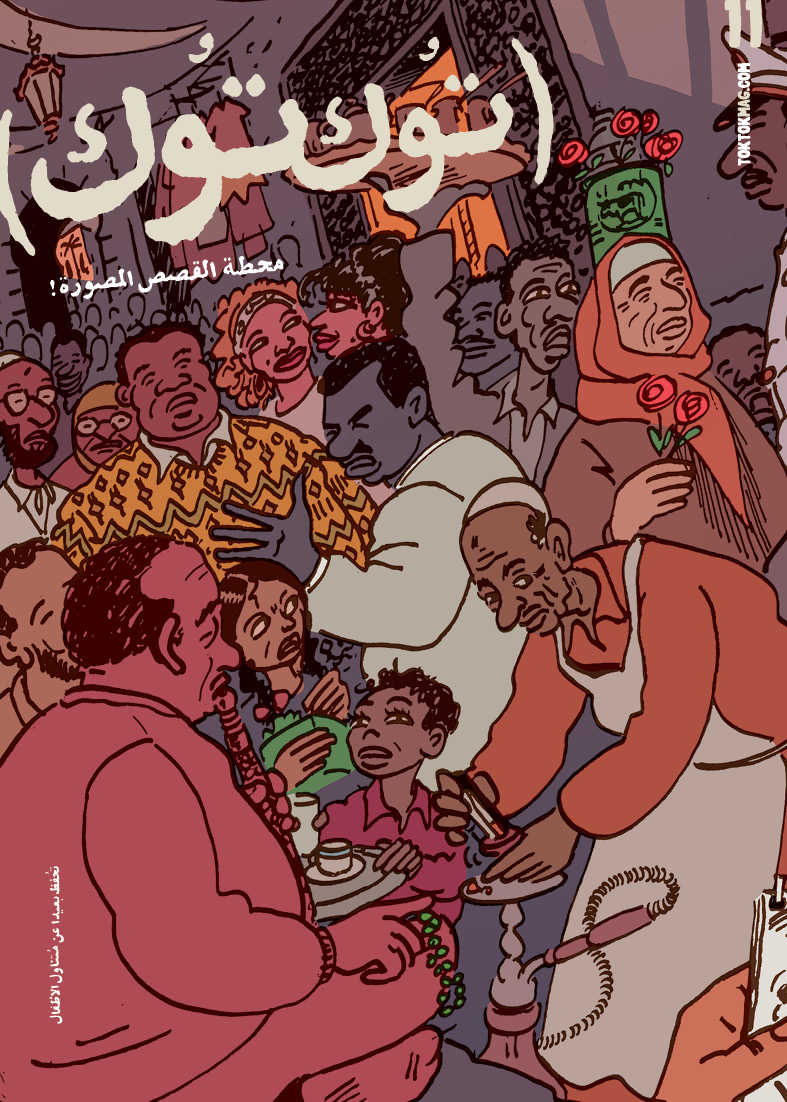During « Des bulles et des fouilles » meeting, two guest artists, share their view on graphic edition in Egypt. Although their influence are diverse and their style are different, both of them recognize the influence of Egyptian artists from the 1970’s and notice a turning point in Egyptian publishing, in the mid-2000.
Shennawy studied fine arts with a specialization in advertising. Passionate about comics, he founded in 2010 « Toktok » magazine, along with a group of artists. Sharif el-Sayed studied fine arts with a specialisation in settings. He is an art director in Arab Academy for Science, Technology and Maritime Transport in Alexandria. His artistic creation is oriented to young people through album illustration and artistic workshops. He illustrated more than 60 albums, created a web cartoon, « Zlezla » and founded « Khayal » festival.
Shenawwy and comics in Egypt
MEDiakitab : Originally « Toktok » was founded to propose comics for adult in Egypt. Do you have other examples of this kind of publication in Egypt ?
Shenawwy : In Egypt, illustrated books for adult are difficult to find. Image books, like comics or illustrated texts, are associated with children. But pioneers gave us inspiration. In the 70’s passionated drawers founded children magazine, comics or albums. Most of them had studied in Europe. Among them, some artists made research at a visual level, like Moha el din al-Abbad.
MEDiakitab : This year in Marseille, fotokino showed an exhibition about illustrators for children in the Arab world, including a part about al-Abbad. It was named « Regards sur 40 ans de littérature jeunesse ».
Shenawwy : And Walid Taher came during the exhibition. In our group, we all feel respect for al-Abbad, his comments and graphic researches. He refused to simply copy European style and wanted to find his proper style based on traditional Egyptian art. Then, in the 1990’s, a publication named Flash was published. It was the only publication written in Egyptian dialect, at the time. It was very sucessful all over Arabic world. Everybody knew it from Marroco to Yemen. Then it stopped in the early 2000s.
MEDiakitab : The magazine Flash also aimed at children ?
Shenawwy : The magazine rather aimed at young people, highschool and university students. I read it even after leaving university. It staged realistic stories with a social dimension. The leading role was played by a skeleton standing for the average citizen or employee, who cannot eat or spend money… But the magazine disappeared at the end of 1990’s and let an empty space. That is why we wanted to continue along this path of comics publication.
MEDiakitab : According to you « Toktok » publication filled a void ?
Shenawwy : Not really. In 2006, an Egyptian author published a comic album for adults : « Metro ». The story included insults and political messages. One week after the publication, the album was removed by police. That is why the word comics, « qisas musawara » in Arabic, gradually came back in our collective psyche. The first edition was published in january 2011, two weeks before revolutionary events which revealed a graphic expression. Streets became space for expression with many graffitis and stencils. Young people became more interested in visual expression. Many graphic creation, radio reports or video on Internet were dealing with daily life of common people. There was a real need for independant creation. This movement boosted our project. As soon as the first edition was launched, 500 copies had been sold within 2 or 3 hours. Many peuple were coming in the exhibition room. We felt supported and we understood that our project was not just a pipe dream. We were dealing with subjects that resonated with people daily life. We were telling streets stories, about daily life, social life. Then, the second issue was completly dedicated to political subjects.
Sharif el Sayed and book illustration for children
MEDiakitab : As a book illustrator, how did your profession developped in the Egyptian context ?
 Sharif El Sayed : I have been working as a book illustrator, since 1996. In the beginning it was my profession so I produced many books. But after 2001, I have focused more on new media and the production rythm decreased to one book every two years. At first, my style looked like cartoons. It was partly besause of Egyptian market. We had problems in printing and quality was not very good. The book were coloured by computers with thick ink, so publishing houses were encouraging visible black lines to facilitate the printing stage. Then a turning point happened in the mid 2000. The boom was prepared during the 1990’s : many Egyptian publishers participated in workshops in Germany, in Franckfort book fair. Then, in the mid 2000’s some funds like Anna Lindh, Goethe Institute or national competition supported book production. Publishing and print industry improved. They were pushed to find new ideas and technics because of international competition. It was very interesting. So the quality improved and many Egyptian illustrators and writers became visible and well known in Egypt. My latest book might be published soon. I illustrated the story during the Revolution. It deals with the Egyptian character, the tendency to complain, to criticize the people around without seeing the positive points. It was a team work with my friend Kohinour who wrote the story.
Sharif El Sayed : I have been working as a book illustrator, since 1996. In the beginning it was my profession so I produced many books. But after 2001, I have focused more on new media and the production rythm decreased to one book every two years. At first, my style looked like cartoons. It was partly besause of Egyptian market. We had problems in printing and quality was not very good. The book were coloured by computers with thick ink, so publishing houses were encouraging visible black lines to facilitate the printing stage. Then a turning point happened in the mid 2000. The boom was prepared during the 1990’s : many Egyptian publishers participated in workshops in Germany, in Franckfort book fair. Then, in the mid 2000’s some funds like Anna Lindh, Goethe Institute or national competition supported book production. Publishing and print industry improved. They were pushed to find new ideas and technics because of international competition. It was very interesting. So the quality improved and many Egyptian illustrators and writers became visible and well known in Egypt. My latest book might be published soon. I illustrated the story during the Revolution. It deals with the Egyptian character, the tendency to complain, to criticize the people around without seeing the positive points. It was a team work with my friend Kohinour who wrote the story.




